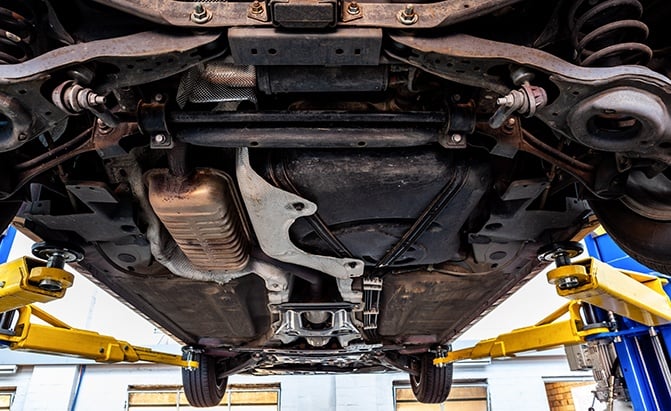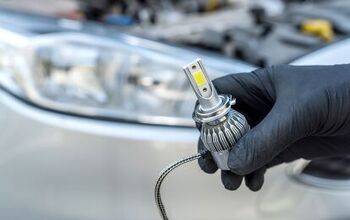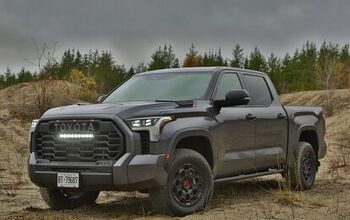The Best Undercoating Products to Keep Your Vehicle Rust-Free
If you are the kind of driver who prefers to keep your vehicles for many years, you will know well that rust is one of the most significant obstacles to keeping your car or truck roadworthy. Rust is the result of a chemical reaction that occurs when untreated metal is exposed to water or moisture-laden air, conditions that frequently exist in many coastal locations. And if you live in a part of the country where snow and ice are a regular part of winter, you will have noticed that the salt used to treat slippery roadways accelerates the corrosion process.
While many new vehicles leave the factory with some degree of rust protection, if you want your vehicle to remain rust-free for as long as possible, you must treat it annually with an aftermarket corrosion prevention product. One of the most common types of these is undercoating. When applied to your vehicle’s undercarriage, the best undercoating products will help prevent rust-related damage to floor panels and critical structural and suspension components. Although there are many professional companies that provide rust protection services for your vehicle, some of the best undercoating solutions come in convenient packaging so that you can apply them to your vehicle yourself.
As you might expect, there’s a lot of variety out there, so choosing the right product solution can be a daunting task. That’s why we’ve compiled a list of the best undercoating sprays so you can keep your vehicle rust-free for years to come.
For more information on the best undercoating products, refer to our table of contents.
Table of contents
- 1. Editor’s Pick: Rust-Oleum Professional Grade Undercoating Spray
- 2. Best for Large Projects: Fluid Film Undercoating
- 3. 3M Professional Grade Rubberized Undercoating
- 4. Rusfre Spray-On Rubberized Undercoating
- 5. Woolwax Automotive Undercoating
- How and when should you apply undercoating?
- What safety precautions should you take when applying undercoating?
- Should you choose a product that comes in a spray can, or in a pail or jug?
- What are some side benefits to applying undercoating?
- Recent Updates:
1. Editor’s Pick: Rust-Oleum Professional Grade Undercoating Spray
Here’s a product that does exactly what it says on the can, which is to provide protection for your vehicle against the ravages of rust and other damage that can occur on the road. Rust-Oleum is no newcomer to this field: it was created about 100 years ago based on the discovery that oil spilled on the metal deck of a boat inhibited the formation of rust. We figure if a product is good enough to work in an unforgiving marine environment, you can also trust it to protect your car from winter road salt.
This is a rubberized spray that you apply just like spray paint, but as it dries, it turns into a thick, damage-resistant coating. Rust-Oleum says the product takes about an hour to dry to the touch. Each can of Rust-Oleum covers between 10 to 15 square feet, so you will definitely need more than one can if you hope to cover the entirety of your vehicle’s underbody. Thankfully, you can buy this undercoating in a six-pack as well as single cans. The can itself is designed to spray at any angle—even upside down.
Pros | Provides sound deadening as well as rust protection; dries quickly, can sprays at any angle |
Cons | Some buyers say the product appears little different from Rust-Oleum’s less-expensive, standard-grade undercoating, multiple cans required for good coverage |
2. Best for Large Projects: Fluid Film Undercoating
If you require a large volume of high-quality undercoating, we recommend this product from Fluid Film. The company says its undercoating was created for industrial applications, primarily on large ships and offshore oil rigs, where corrosion is a massive problem. No wonder you can buy this product in a huge, five-gallon pail.
Despite the size of the container, you are meant to spray, not brush, this product onto your vehicle. Because it is quite thick, it’s recommended that you apply this undercoating in warm weather when the product is in its most fluid state. One buyer said they had the best success using Fluid Film’s professional-grade spray gun. And while this product’s price may be off-putting, consider that this pail costs about what you’ll pay a professional to apply undercoating to your vehicle—and you’ll get multiple applications out of this amount of the product. Fluid Film says its formulation is non-toxic.
The only reason we didn’t make this product our Editor’s Pick is because it's less practical for DIY application than the Rust-Oleum corrosion inhibitor that made the number one spot.
Pros | An effective way to protect your vehicle from corrosion, good value, non-toxic |
Cons | Comes in an unwieldy, heavy pail, you must buy a separate sprayer to apply this undercoating |
3. 3M Professional Grade Rubberized Undercoating
The number three spot on our list of the best undercoating products goes to another recognizable name in vehicle protection, 3M. It comes in a convenient spray can that goes on black and dries to a rubberized, flexible surface that will protect your vehicle’s metal from corrosion-causing salt and damage from other road hazards.
As is the case with many undercoating products, this one also provides some sound-deadening, so your vehicle will be a little quieter after you apply 3M’s undercoating. While it is recommended that you apply this spray to a clean, dry surface, you do not need to prime the metal first as you would if you were painting it.
Sold in a six-pack of spray cans, your purchase should be enough to coat the underside of a small vehicle; one buyer said they used three cans to cover the bottom of a pickup truck cab. Another buyer recommends buying more than you think you’ll need as this spray goes on thick.
Pros | An effective product from a recognized name, convenient six-pack of spray cans |
Cons | You will probably need more cans than you originally estimate, ultimately, it wouldn’t cost that much more to have your car professionally undercoated |
4. Rusfre Spray-On Rubberized Undercoating
The next undercoating product we found to recommend to you is this spray-on formulation from Rusfre. Packaged in a one-gallon container, Rusfre says its undercoating is designed to be used with the company’s own applicator gun. That will add extra cost to your job but will ensure the product goes on your vehicle as intended and provides the best possible protection. On the plus side, this container should be enough to completely coat the underside of almost any passenger vehicle.
Like most other undercoating products, Rusfre’s is rubberized, so it provides some sound-deadening qualities along with protecting your vehicle from rust and other damage. The liquid contains bound fibers to help it bond to your vehicle’s metal and prevent it from chipping, cracking, or peeling after it dries. While Rusfre makes no claims about its undercoating being non-toxic, it does say it is asbestos-free, making it that much safer for you to use.
Rusfre recommends that you apply its undercoating at room temperature (about 68 degrees F) or warmer after stirring and shaking it well.
Pros | An effective product packaged in a high-value and convenient one-gallon jug, provides sound deadening qualities |
Cons | Require spray gun is expensive, can take up to a week to fully cure |
5. Woolwax Automotive Undercoating
Our final undercoating recommendation comes from Woolwax, which is made from lanolin, a naturally occurring wax secreted by wool-bearing animals like sheep. While Woolwax stops short of claiming its undercoating is “all-natural,” it does say the product contains no solvents and is non-hazardous and environmentally friendly. In theory, that makes it potentially less harmful to you if you accidentally inhale its vapors or get the product on your skin; however, Woolwax says the real benefit is that the lack of solvents helps prevent its undercoating from evaporating over time. That means that once you apply it, your vehicle will be protected for longer.
Woolwax makes its undercoating thick enough to prevent dripping but fluid enough to spray using one of its proprietary sprayer designs, which you have to buy separately. Once you have applied this undercoating, it will cure and thicken to a gel-like consistency. That means it stays flexible and will “heal” itself if the coating is scratched.
While this Woolwax formulation is black, you can also buy a clear version. Woolwax also makes an undercoating product in a spray can for more convenient application.
Pros | Almost no smell, no solvents reduces evaporation, does not wash off easily |
Cons | Must be applied with proprietary sprayer at extra cost, one-gallon can is not a particularly convenient package |
How and when should you apply undercoating?
Photo credit: Virrage Images / Shutterstock.com
Generally, you’ll get the best results by applying undercoating in milder weather, at temperatures around 68-degrees F or warmer. That’s because while these products come in liquid form, they are thick and get even thicker when they’re cold. So even though you’re likely using undercoating to protect your vehicle primarily against road salt used in winter weather, you should apply it well before cold weather arrives.
Among the more forgiving products is Rust-Oleum’s undercoating spray, which the company says you can apply at temperatures above 50-degrees F.
What safety precautions should you take when applying undercoating?
Most undercoating products contain chemicals that can cause you serious harm if you inhale them or get the product on your skin. When applying undercoating, we recommend that you wear rubber gloves, an N95-type mask to prevent you from inhaling vapors, and eye protection.
Also, be sure your workspace is well ventilated. If you’re working in your garage, open the door; even better, park your car on the driveway while you’re applying undercoating.
Should you choose a product that comes in a spray can, or in a pail or jug?
As with most products, you’ll get a better deal on undercoating if you purchase it in larger quantities. However, before you buy something like a five-gallon pail of Fluid Film’s product in the number two spot on our list, consider your needs. If you only have one vehicle to protect from rust, buy it in spray cans for convenience’s sake.
Products that come in a pail or jug require you to buy a separate spray gun, which is an additional cost to consider. If you own several vehicles to which you will apply your own undercoating every year, that extra cost may be worthwhile. But otherwise, you’ll appreciate the convenience of buying spray cans; you can find spray can multi-packs of undercoating products, an option that will save you a few dollars over buying individual cans.
What are some side benefits to applying undercoating?
Among the most-touted side benefits of rubberized undercoatings is that they possess sound-deadening qualities. After you apply one of these products to the underside and wheel wells of your vehicle, you should notice a minor reduction in the amount of road noise in the cabin, especially at highway speeds.
Also, some undercoating products will also help prevent fasteners from rusting stuck. If you choose an undercoating that promises this, it should make some future repairs, like replacing worn suspension parts, easier by helping to prevent rusted nuts and bolts from breaking when you try to loosen them.
Recent Updates:
November 23, 2022: Updated product links.
We are committed to finding, researching, and recommending the best products. We earn commissions from purchases you make using the retail links in our product reviews. Learn more about how this works.
Photo credit: Greg Brave / Shutterstock.com
More by Chris Chase






































Comments
Join the conversation
Have you heard of new Hampshire oil undercoating ? I was thinking about trying it, but I was looking for some good reviews......